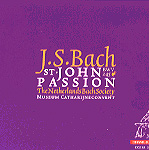As with the work itself, there’s no recording of Bach’s St. John Passion that stands as preeminent and certainly none that can claim to be definitive. But, if you accept Jos van Veldhoven’s decisions regarding certain key aspects of this performance–including the reconstruction of some parts–this one comes very close. Aside from the various versions of the score that Bach himself created, performances are widely varied in terms of instrumentation (numbers and types of instruments and how they are used) and vocal forces (most significantly, how many singers to a part). Here, Veldhoven has chosen to attempt to reconstruct and perform the St. John in a version as close as possible to what was heard at the work’s premiere in 1724. You can read the rationale for and details of this effort in the excellent liner notes, but suffice it to say that some guesses and reconstructive decisions had to be made in several cases, both in vocal and orchestral parts. Most shocking to listeners familiar with this work is the total absence of flutes, which opens up the orchestral sound to a new and very different world of color.
The fact that Veldhoven also employs only six strings, two oboes, organ, theorbo, and harpsichord for his orchestra makes a surprisingly rich-toned yet keenly detailed ensemble. This is well-balanced against his correspondingly minimal vocal forces–a set of six soloists fortified where necessary and appropriate with a quartet of “ripienists”. While I’ve never been a fan of this one- or two-to-a-part concept–it usually sounds thin, anemic, and pathetically underpowered, especially in the major choruses–here I only occasionally wished for the fuller, rounder body that only additional voices can supply. In a word, I was surprised at how solid and strong the balances are and how vibrant the sound–certainly this is the best-sounding St. John available on disc, and I noticed that on my system at least, it blossomed even more fully by turning the volume up just a couple of notches from its usual position.
The vocal performances are first-rate, with special mention to Evangelist Gerd Türk and tenor Charles Daniels. Likewise, the instrumental players are technically assured and always sensitive to text and singer, and invariably tasteful in solo passages and recitatives. It’s nice to hear the theorbo so clearly and effectively punctuating the recits. My only complaint regarding the performers is alto Peter de Groot, whose hooty quality is more or less apparent depending on register and dynamic level. Happily, his very important dramatic moment–the aria “Es ist vollbracht!” (It is fulfilled)–is exceptionally lovely (except for the rapid passages near the end), and here the continuo work also is exemplary. Veldhoven’s leadership is sure and finely articulated, with well-considered tempos and a natural flow to lines and phrases.
As with its beautifully packaged Christmas Oratorio (read the review in our archive), Channel Classics again offers these discs in a handsome box, accompanied by a hard-bound, 192-page book with full-color art reproductions and commentary, produced in conjunction with the Museum Catharijneconvent, Utrecht. However, listeners who just want to follow the text will have to deal with the same annoying problem as before: the pages containing the texts are regularly interrupted by several intervening pages of art reproductions and descriptions. While it’s wonderful to have, why couldn’t the art and Passion texts be set in their own convenient but separate, easy-to-follow sections? Of course, none of this has anything to do with the music or performances–and you won’t find better, more deeply committed or finer-sounding renditions anywhere. You may not agree with Veldhoven’s fundamental choices regarding performance practice or with his editorial realizations, but if you’re a Bach fan, this is serious and significant music-making that upholds the integrity of Bach’s score while offering an intelligent and artistically enlightening addition to the Bach catalog.
































